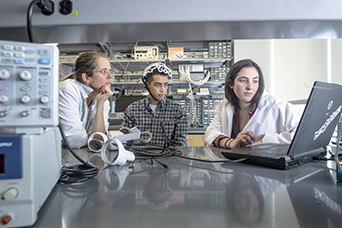In This Story

When Nathalia Peixoto was growing up in Brazil, she told people she wanted to be a teacher and an engineer when she grew up.
“My brother and sister made fun of me, saying that those don’t go together,” says Peixoto, an associate professor in the Department of Electrical and Computer Engineering (ECE), and an affiliate faculty member with the Department of Bioengineering. “My mom never finished her first year of college, so it was not clear that anyone in our family would go to college.”
But Peixoto was determined. She went to a vocational-technical school instead of a traditional high school and became a technician in electronics and robotics, working with five engineers. “When I disagreed with them, or they asked me to do things that I thought were wrong, they said, ‘Unless you have a bachelor’s degree, you can’t call any shots.’”
So Peixoto went on to get an undergraduate degree, PhD, then conduct research at the University of Bonn in Germany as well as Stanford University before coming to Mason in 2004 as a post-doc in the physics department. She joined the Volgenau School of Engineering in 2006 as an assistant professor in ECE.
Now Peixoto is living her childhood dream, combining her love for teaching and engineering while mentoring young women, like herself, who had to overcome obstacles to become engineers. “I prefer to help people who have difficulties navigating the academic world,” says Peixoto, who won Mason’s Teaching Excellence Award in 2015.
As a supervisor for the Society of Hispanic Professional Engineers (SHPE), she meets with minority students, sharing stories of her journey, providing guidance on job searches and applying to graduate school, and tips on finding a lab to conduct research while an undergraduate.
She has worked with students she met in classes, in the hallway, through other professors, during her presentations to middle and high school students, and at Mason’s Aspiring Scientist Summer Internship Program.
Peixoto estimates she has mentored hundreds of students over the years, often supervising their research projects. Currently, she is overseeing nine independent research projects led by high school and undergraduate students, three ECE senior design team projects, as well as three research projects in her Neural Engineering Lab, which is affiliated with both the ECE and Bioengineering departments and is part of the Institute for Biohealth Innovation.
Her high school, undergraduate, and graduate students perform team-based projects on assistive technology, wearable embedded systems, and neural implants.
“One of the things I’ve learned is that our best students bloom if you give them freedom,” Peixoto says.
For one of her funded research projects, a graduate student is creating a device that uses wireless signals to detect people’s heart rate and breath behind walls of rubble. “It could be used to detect a person who was buried because of an earthquake or in a war zone,” she says.
The U.S. Air Force is funding the project. “There’s a lot of math behind it and hardware/software development to be done to make it work, but I am hopeful it will be really useful.”
For another project, she’s working with an epidemiologist to develop a portable robot that can collect ticks, which will help for research on tick-borne diseases.
In another, she’s working with a Social Work professor at Mason on virtual-reality tools to help people who are recovering from addiction. Her expertise here is on analyzing brain signals and the physiological state of the user during exposure to triggers.
She is also a co-investigator on a prestigious Research Traineeship grant of nearly $3 million from the National Science Foundation to cross-train graduate students over the next five years.
Peixoto appreciates the flexibility she has at Mason to wear many hats. “I have the perfect balance of how much I can interact with students, how much I can mentor them, and I can allow them to do whatever research they want.
“After students leave Mason, they often keep in touch and let me know how their professional and personal lives are going,” she says. “Their stories become part of mine, they always have their experiences at Mason impact them, and it is gratifying for me to see and be part of that.”
